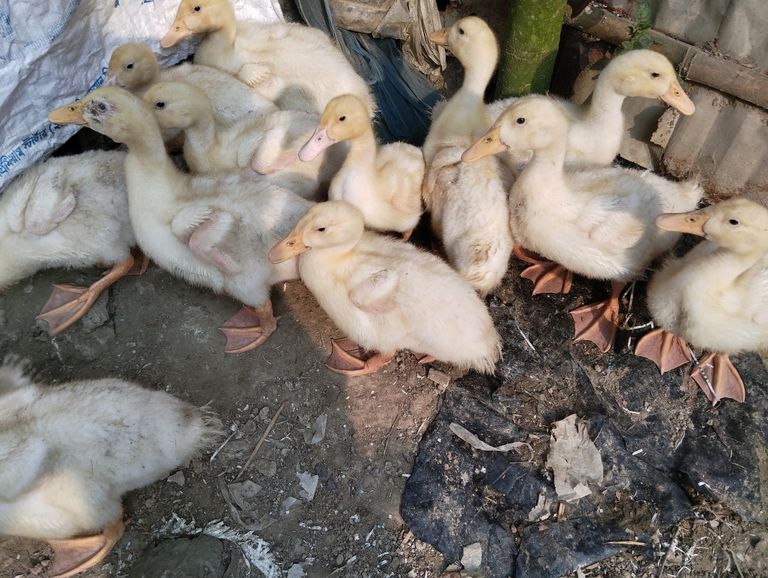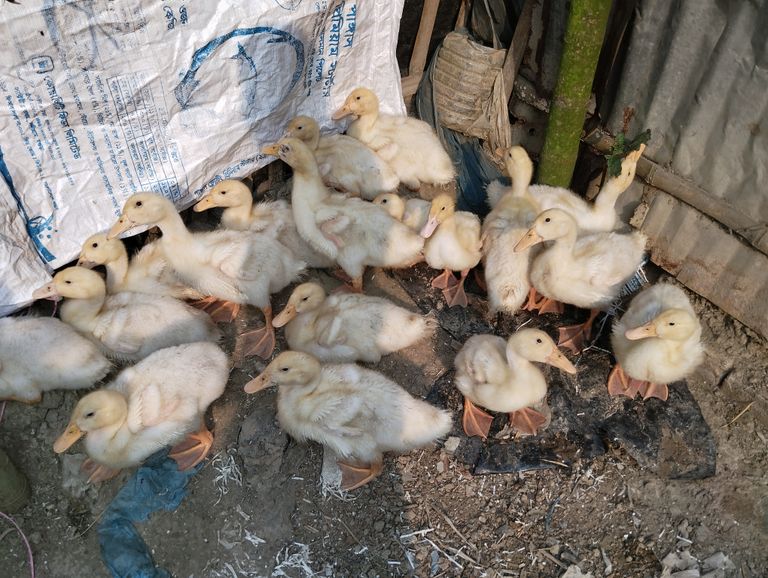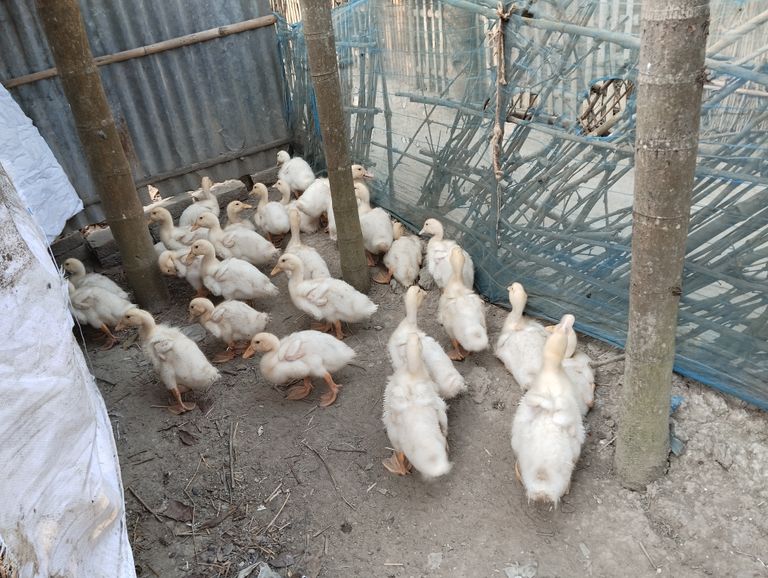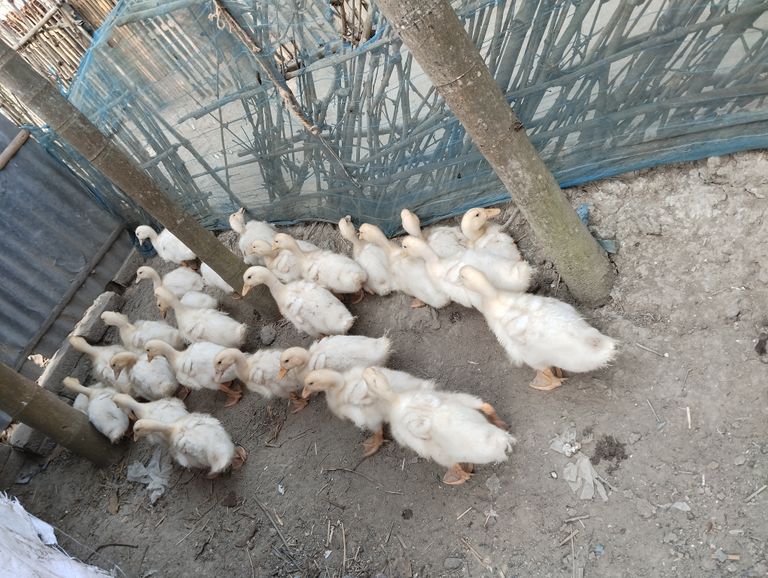
Campbell Duck Farming A Complete Guide.
Campbell ducks are among the most popular duck breeds for farming due to their excellent egg production, adaptability, and ease of management. This guide covers everything you need to know about Campbell duck farming, from selecting the right breed to feeding, housing, and health care.
Why Choose Campbell Ducks for Farming?
Campbell ducks, particularly the Khaki Campbell variety, are widely known for their high egg production and hardiness. Here are some key reasons to consider raising them:
- High Egg Production – A healthy Campbell duck can lay up to 300–340 eggs per year.
- Low Maintenance – They require less space and food compared to chickens.
- Hardy and Adaptable – They can thrive in various climates and farming conditions.
- Dual-Purpose Use – While primarily raised for eggs, they also provide good-quality meat.
Setting Up a Campbell Duck Farm
- Selecting the Right Ducks
Khaki Campbell – Most popular due to its superior egg-laying ability.
White Campbell – Known for good egg production and meat quality.
Dark Campbell – Less common but still productive.
When buying ducklings, ensure they are healthy and active. Purchase from a reputable breeder to get high-quality stock.
- Housing Requirements
Campbell ducks do not require complex housing, but they need a safe and comfortable shelter.
Housing Guidelines:
Space – Provide at least 3–4 square feet per duck in the coop.
Ventilation – Ensure proper airflow to keep the area dry.
Bedding – Use dry straw, wood shavings, or sawdust.
Protection – Secure the house from predators like foxes, snakes, and stray dogs.
Nesting Boxes – Each duck needs a separate nesting area to lay eggs comfortably.
- Feeding and Nutrition
Proper nutrition is key to maximizing egg production and keeping ducks healthy.
Recommended Diet:
Starter Feed (0–3 weeks): High-protein feed (18–20%) for rapid growth.
Grower Feed (4–16 weeks): Balanced feed with 16% protein.
Layer Feed (17 weeks+): 16–18% protein with calcium for strong eggshells.
Green Vegetables & Grains: Ducks enjoy leafy greens, wheat, maize, and rice bran.
Water Access: Ducks need constant access to clean water for drinking and feeding.
- Breeding and Egg Production
Campbell ducks start laying eggs at five to six months old.
Provide sufficient light (14–16 hours daily) to maintain high egg production.
Collect eggs regularly to keep them clean and prevent breakage.
Ducks can breed naturally, but artificial incubation can improve hatch rates.
- Health Management
Maintaining the health of your ducks is essential for a successful farm.
Common Duck Diseases & Prevention
Regularly inspect your ducks for signs of illness and consult a vet when needed.
Campbell Duck Farming for Profit
Campbell ducks are an excellent investment for farmers due to their high egg yield and relatively low maintenance. Here’s how you can maximize your profit:
- Sell Fresh Duck Eggs – Market them locally or online for a steady income.
- Duck Meat Sales – Older ducks or surplus males can be sold for meat.
- Duck Manure as Fertilizer – Their droppings are a great organic fertilizer.
- Breeding and Selling Ducklings – Sell healthy ducklings to new farmers.
Cost and Profit Estimation
A well-managed farm can start generating profits within 6–12 months.
Final Tips for Success
Choose high-quality ducklings for better egg production.
Maintain clean water and a healthy diet for optimal growth.
Provide proper housing and security to prevent losses.
Market your eggs and ducks effectively to maximize sales.
Campbell duck farming is an excellent business opportunity with great returns. With proper care and management, you can build a successful and sustainable duck farming enterprise.

How to Care for Campbell Ducklings: A Complete Guide
Campbell ducks are a popular breed known for their excellent egg-laying abilities and friendly nature. Raising Campbell ducklings requires proper care to ensure their health and growth. This comprehensive guide will help you understand how to take care of Campbell ducklings from hatching to adulthood.
- Preparing for the Arrival of Campbell Ducklings
Before bringing your Campbell ducklings home, you need to prepare a safe and comfortable space for them.
a) Brooder Setup
A brooder is a warm and secure space where ducklings stay for the first few weeks.
Container: Use a large plastic tub, wooden box, or a special brooder pen.
Bedding: Line the bottom with absorbent materials like straw, pine shavings, or paper towels. Avoid slippery surfaces.
Heat Source: Use a heat lamp or brooder plate to maintain warmth. The temperature should be around 35°C (95°F) in the first week and gradually reduced by 3-5°F per week.
Ventilation: Ensure proper airflow to prevent respiratory problems.
b) Water and Food
Campbell ducklings need a balanced diet and constant access to clean water.
Water: Use shallow water containers to prevent drowning. Change the water frequently to keep it clean.
Food: Provide high-quality duck starter feed (20% protein) for the first three weeks, then transition to grower feed (15-16% protein).
Avoid Medicated Feed: Medicated chick feed contains additives that can be harmful to ducklings.
- Daily Care for Campbell Ducklings
Proper daily care ensures healthy growth and development.
a) Feeding Routine
Offer fresh food and water at all times.
Clean feeders and waterers daily to prevent contamination.
Introduce chopped greens and small insects after two weeks for extra nutrients.
b) Maintaining the Right Temperature
Keep the brooder warm but allow ducklings to move away from the heat if needed.
Observe their behavior: if they huddle together, they are cold; if they move away from the heat source, it’s too hot.
c) Keeping the Brooder Clean
Remove wet bedding daily to prevent mold and bacteria.
Change bedding at least twice a week.
Ensure dry and clean surroundings to prevent diseases.
- Health and Safety Tips
Keeping ducklings healthy is essential for their survival.
a) Common Health Issues
Splayed Legs: Caused by slippery surfaces. Use proper bedding and provide niacin supplements.
Pasting Up: Droppings stick to their vent. Clean gently with warm water.
Respiratory Issues: Caused by poor ventilation or dusty bedding. Maintain clean and airy conditions.
b) Protection from Predators
Keep them indoors or in a secure pen.
Avoid placing the brooder near cats, dogs, or rodents.
- Transitioning to an Outdoor Coop
At around 6-8 weeks, Campbell ducklings are ready to move outdoors.
a) Preparing the Coop
Shelter: Provide a well-ventilated, dry, and predator-proof duck house.
Bedding: Use straw or pine shavings to keep them comfortable.
Fencing: Ensure a secure outdoor area for foraging and exercise.
b) Introducing Water for Swimming
Start with shallow water dishes.
Allow supervised swimming sessions in lukewarm water after 2-3 weeks.
Never leave ducklings unsupervised in deep water.
- Socialization and Training
Campbell ducks are social animals and enjoy companionship.
a) Handling Ducklings
Handle them gently from a young age to build trust.
Avoid sudden movements that may scare them.
b) Introducing to Other Ducks
If raising multiple ducks, introduce them gradually.
Observe their interactions to prevent bullying.
- Final Tips for Raising Healthy Campbell Ducks
Patience is Key: Ducklings grow fast but require attention in the early weeks.
Proper Nutrition: Ensure they get the right feed and supplements.
Clean Environment: Maintain hygiene to prevent diseases.
Safe Housing: Protect them from predators and harsh weather. By following these guidelines, you can successfully raise healthy and happy Campbell ducklings. Whether you keep them for eggs, as pets, or for farm purposes, they will thrive with proper care and attention.

Common Diseases on Campus: Causes, Prevention, and Solutions
College campuses are vibrant communities where students from diverse backgrounds come together to learn, socialize, and grow. However, living in close quarters, sharing facilities, and engaging in social activities also make campuses hotspots for various diseases. Understanding common campus illnesses, their causes, prevention, and treatment can help students stay healthy and enjoy their college life to the fullest.
- Common Diseases on Campus
a) Flu and Common Cold
These viral infections spread rapidly among students due to close interactions, shared living spaces, and poor hygiene. Symptoms include fever, cough, sore throat, and fatigue.
b) Gastrointestinal Infections (Food Poisoning & Stomach Flu)
Contaminated food and water in dormitories or cafeterias can lead to food poisoning and stomach flu. Symptoms include nausea, vomiting, diarrhea, and stomach cramps.
c) Meningitis
Meningitis is a serious infection affecting the brain and spinal cord, caused by bacteria or viruses. It spreads through respiratory droplets, making crowded dormitories a high-risk area. Symptoms include severe headache, fever, stiff neck, and nausea.
d) Mononucleosis (“Mono” or the Kissing Disease)
Caused by the Epstein-Barr virus, mono spreads through saliva. Symptoms include extreme fatigue, fever, sore throat, and swollen glands. It can take weeks to recover.
e) Sexually Transmitted Infections (STIs)
Unprotected sexual activities increase the risk of STIs like chlamydia, gonorrhea, syphilis, and HIV. Many STIs show no early symptoms, making regular screening essential.
f) COVID-19 and Respiratory Illnesses
Although the pandemic has subsided, COVID-19 and other respiratory diseases like pneumonia and bronchitis still pose risks. Symptoms vary from mild cough and fever to severe breathing difficulties.
g) Skin Infections (Ringworm, Scabies, and MRSA)
Sharing towels, clothes, or gym equipment can spread fungal infections like ringworm or bacterial infections like MRSA (Methicillin-resistant Staphylococcus aureus). These infections cause skin irritation, redness, and itching.
h) Mental Health Issues (Depression & Anxiety)
While not a contagious disease, mental health problems like depression, anxiety, and stress-related disorders are prevalent among students due to academic pressure and social challenges. Symptoms include persistent sadness, insomnia, loss of concentration, and withdrawal from social activities.
- Causes of Diseases on Campus
Several factors contribute to the spread of diseases in college settings:
Crowded Living Spaces – Dormitories, classrooms, and dining halls increase the risk of infections.
Poor Hygiene Practices – Not washing hands, sharing personal items, or neglecting cleanliness can spread germs.
Unhealthy Eating Habits – Junk food, lack of nutrition, and unsafe food handling contribute to gastrointestinal diseases.
Lack of Sleep & Stress – Weakened immune systems due to late-night studies and stress make students prone to illnesses.
Unprotected Sexual Activities – Engaging in risky behavior without protection increases STI risks.
Limited Access to Healthcare – Many students ignore symptoms due to busy schedules or lack of medical facilities.
- Prevention and Healthy Campus Habits
Preventing diseases on campus requires personal responsibility and community awareness. Here are some essential preventive measures:
a) Personal Hygiene
Wash hands frequently with soap and water.
Avoid sharing personal items like towels, razors, and water bottles.
Use hand sanitizers when necessary.
b) Healthy Eating & Hydration
Eat a balanced diet rich in vitamins and minerals to boost immunity.
Drink plenty of water and avoid unclean food sources.
c) Vaccination & Medical Checkups
Get flu shots and other necessary vaccines like meningitis and HPV.
Regular medical checkups help detect and prevent potential health issues.
d) Safe Social Interactions
Maintain a safe distance if someone is sick.
Use protection during sexual activities to prevent STIs.
e) Clean Living Environment
Keep dorm rooms and shared spaces clean.
Regularly disinfect frequently touched surfaces.
f) Mental Well-being & Stress Management
Get adequate sleep and practice relaxation techniques.
Seek counseling or mental health support when needed.
- What to Do If You Get Sick on Campus?
Despite preventive measures, falling sick is sometimes inevitable. Here’s what to do:
Visit the campus health center for professional medical advice.
Inform your professors if your illness affects class attendance.
Isolate yourself if you have contagious symptoms like fever or diarrhea.
Stay hydrated and rest to help your body recover faster.
Follow prescribed medications and avoid self-medication.
Maintaining a healthy lifestyle on campus is essential for academic success and overall well-being. By understanding common campus diseases, their causes, and preventive measures, students can reduce health risks and enjoy a fulfilling college experience. A combination of good hygiene, proper nutrition, vaccination, and mental health care is the key to staying healthy.

Vaccination Programs for Camels
Camels are vital animals in many parts of the world, serving as a primary means of transportation, milk and meat production, and even cultural heritage. However, like all livestock, camels are susceptible to various diseases that can impact their health, productivity, and economic value. To protect camels and prevent the spread of infectious diseases, proper vaccination programs are essential. This blog will provide an in-depth look at the key vaccination programs for camels, the importance of immunization, and best practices for maintaining camel health.
Why Vaccinate Camels?
Vaccinating camels is crucial for several reasons:
- Disease Prevention: Vaccines help prevent common bacterial and viral infections that can cause severe illness or death.
- Economic Stability: Protecting camels from disease ensures the stability of the camel industry, reducing financial losses for farmers and herders.
- Public Health Protection: Some camel diseases can spread to humans (zoonotic diseases), making vaccination essential for both animal and human health.
- Improved Productivity: Healthy camels produce more milk, meat, and work efficiently in transportation and other activities.
Common Camel Diseases and Vaccines
- Peste des Petits Ruminants (PPR)
Cause: PPR virus (a Morbillivirus)
Symptoms: Fever, nasal discharge, diarrhea, pneumonia, and ulceration in the mouth.
Vaccine: PPR live attenuated vaccine
Dosage & Schedule: Given annually or every two years, depending on outbreak risks.
- Rift Valley Fever (RVF)
Cause: Rift Valley Fever virus (Bunyavirus)
Symptoms: Fever, abortion in pregnant camels, liver damage, and high mortality in young animals.
Vaccine: Live or inactivated RVF vaccine
Dosage & Schedule: Given before the rainy season when mosquito populations increase, with booster doses as required.
- Camel Pox
Cause: Camel pox virus (Orthopoxvirus)
Symptoms: Skin lesions, fever, swollen lymph nodes, and respiratory distress.
Vaccine: Live attenuated or inactivated camel pox vaccine
Dosage & Schedule: Usually given once, with boosters every two to three years.
- Brucellosis (Brucella melitensis and Brucella abortus)
Cause: Brucella bacteria
Symptoms: Reproductive failure, abortions, infertility, and joint problems.
Vaccine: S19 or RB51 Brucella vaccine
Dosage & Schedule: Given at 3-8 months of age, with no booster required.
- Anthrax
Cause: Bacillus anthracis bacteria
Symptoms: Sudden death, high fever, bleeding from body openings, and swelling.
Vaccine: Anthrax spore vaccine
Dosage & Schedule: Annual vaccination in high-risk areas.
- Foot and Mouth Disease (FMD)
Cause: FMD virus (Picornavirus)
Symptoms: Fever, blisters in the mouth and feet, excessive salivation, and lameness.
Vaccine: Inactivated FMD vaccine
Dosage & Schedule: Every six months in endemic regions.
- Hemorrhagic Septicemia (HS)
Cause: Pasteurella multocida bacteria
Symptoms: Swelling in the throat, difficulty breathing, high fever, and sudden death.
Vaccine: HS killed vaccine
Dosage & Schedule: Annual vaccination, especially before monsoon seasons.
Vaccination Schedule for Camels
Best Practices for Camel Vaccination
- Use Quality Vaccines – Always obtain vaccines from certified manufacturers and keep them properly stored at recommended temperatures.
- Follow the Schedule – Administer vaccines on time to ensure effective immunity.
- Hygienic Practices – Use sterile needles and syringes for each animal to avoid infections.
- Observe for Side Effects – Monitor camels for mild reactions such as swelling or fever, and seek veterinary care for severe responses.
- Combine with Other Health Measures – Vaccination should be part of a broader health program, including deworming, nutrition, and parasite control.
Challenges in Camel Vaccination
Despite the importance of vaccination, several challenges exist:
Lack of Awareness: Many herders are unaware of the benefits of vaccination.
Vaccine Availability: Some vaccines are not readily available in remote areas.
Logistics Issues: Transporting and storing vaccines in desert and rural regions can be difficult.
Vaccine Costs: High prices of vaccines may deter small-scale herders from vaccinating their camels.
To overcome these challenges, governments and veterinary organizations should work on education programs, improve vaccine distribution, and subsidize costs for livestock owners.
Vaccination is one of the most effective ways to protect camels from deadly diseases. A well-planned immunization program not only improves camel health but also boosts the economic stability of herders and farmers. By following proper vaccination schedules, maintaining hygiene, and addressing logistical challenges, we can ensure a healthier future for camels and the people who depend on them.
Would you like a specific vaccination guide based on your region or camel breed? Let us know in the comments.